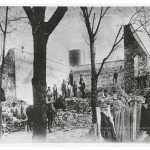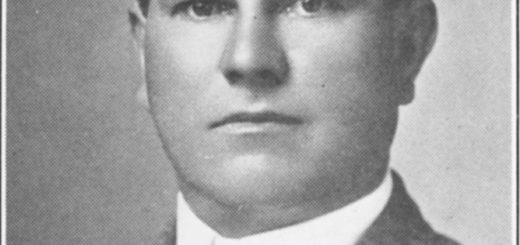John C. Buxton was one of seven men who organized the Winston Water Supply Company in 1880. Their job was to build a water system from scratch. After falling short $6,000 in selling shares in their company, they personally raised $28,000 in order to build a pumping station, a reservoir, and a network of supply lines.
Belo’s Pond was purchased as a water source and a brick and concrete reservoir was constructed on Old Town Street near Eighth Street in 1882. This was near the northern boundary of the city, surrounded by small tenant houses.
The Winston Water Supply Company sold the reservoir to the City of Winston in 1894 after experiencing a series of problems in operating the company. The city added 10 feet in height and 6 feet in length. The reservoir had been leaking for several years, but the leaks did not appear to pose a threat.
In the early hours of this day in 1904, the north wall of the reservoir collapsed, demolishing the home of Martin Peoples who lived next door, and emptying 800,000 gallons of water into the street.
The mighty crash of concrete sounded to many like an earthquake. One man looked out his window to see a huge river coming down the street carrying parts of houses and rubbish. Some people were crushed under the bricks and stone and some were swept away by the powerful force of the water.
The fire alarm rang about 6:00 in the morning from Town Hall, and hundreds of people rushed to the reservoir to assist the injured and to locate missing people. One man escaped injury by clinging to a fence while William Adams and his wife rode out the flood on their mattresses, landing safely 500 yards from their home.
Several people were swept away from their homes toward the railroad junction, which was flooded with water and debris. When the concrete settled, and the water stopped flowing, nine people were killed, several injured, and many homes collapsed or washed away.
At 9:00 on the morning of the disaster, Mayor O. B. Eaton met with the Board of Aldermen in the Municipal Building. He was authorized to provide payment for rebuilding the homes, burying the dead, and treating the injured at the Twin City Hospital.
The reservoir was never used again for water storage. Fortunately for the town, a bond issue was approved in 1903 to build a new iron standpipe which was completed October 12, 1904. The standpipe was located directly behind the reservoir.
The ruins of the reservoir stood for several years after its collapse until small businesses gradually reclaimed the neighborhood. Old Town Street was renamed Trade Street in the late 1890s and the city limits has been extended far beyond the downtown area.
See more photos of the reservoir at www.digitalforsyth.org under the key words: reservoir 1904.
Photo courtesy of Forsyth County Public Library Photograph Collection.






That article about The Pond disaster was informative and full of the living detail that transports me to the very moment. The swift remuneration by the city government was most impressive, compared to certain current policies that seem so different. Note that Abbatoir Street involved another private service that the city acquired and ran into the 19 teens, a slaughterhouse. Thank you for a glimpse into history.
Lifetime Movie Network Has a TV show about ghost and there is a episode based on one of the people that died in this tragedy….
yes, i came here to read about the “flood” because of a woman who died and haunted a hotel where her body “landed.” she had moved into her new house with her husband & son less than 24 hours before being swept away & killed in this unfortunate tragedy.